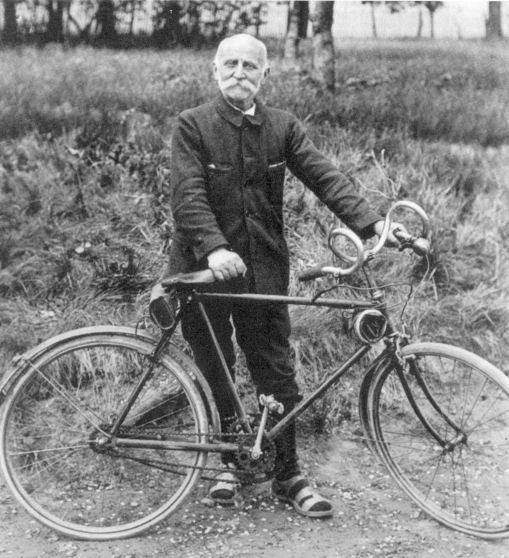Each one creatively pushed into production some idea that has revolutionised cycling. Some inventions have even gone on to revolutionise the car and motorbike industry.
Paul De Vivie – Blood, sweat and gears
Grinding up a grand Col, sweat beading, quads burning. Then a flick of the wrist and the clunk-whirr of the chain, rushing into the body in the form of relief: The derailleurs have lowered the gear, lessened the effort without additional effort. Less than 120 years ago there wasn’t even another gear to change into, all bicycles were single speeds. Many worked on solutions for that, but only one stuck.
French silk merchant Paul De Vivie, born in 1853, was a pioneer of long-distance cycle touring. He first coined the phrase ‘cyclo-tourisme’ and spoke vibrantly of his rides through his alias Velocio in his magazine Le Cycliste.
When gearing first appeared on bikes in the late 1880s, changing was awkward and unreliable. Industry leaders trashed them, branding them an “oddity fit only for invalids and women”. Velocio championed them, and though it’s not clear whether he invented the derailleur or just finessed what British builders had begun, it was his engineering and promoting efforts that led to it being perfected.
At first it was on his own hand-built bicycle La Gauloise up the Col De La Republique near his hometown of St. Etienne, but that progressed to more mammoth challenges, including one in 1902 which pitted female rider Marthe Hesse against professional Edouard Fischer over 200km of hills, Hesse riding with a three-speed Gauloise, Fischer a single speed. Hesse won.
In 1933, Tullio Campagnolo produced the first dependable derailleur. His son Valentino would patent the first electric version nearly 70 years later.
Gerald O’Donovan – Taming the wonder material
1998. That was the last time a bike not made of carbon fibre won a Tour de France. Before it had been steel and then aluminium, until US brand Trek began showcasing their carbon fibre frames in the Grand Boucle under controversial rider Lance Armstrong. That was the time of the great sea of change, driven by Kestrel’s Trek and France’s Peugeot, but the movement had begun at Carlton Cycles in Britain in the 1970s.
Founded in Nottinghamshire, the renowned bespoke bike builder was bought by a British bike manufacturers Raleigh bicycles in 1960 and with it came legendary bike designer and engineer Gerald O’Donovan. His family owned Carlton and had been specialising in creating quality lightweight bikes at mass-production prices. His work caught the eye of Raleigh-riding World Sprint Champion Reg Harris and it was he who pushed the company to buy Carlton to allow O’Donovan to head up its new Specialist Bicycle Development Unit.
In a factory in Derbyshire, expert frame builders worked on future innovations for the professional TI-Raleigh Team, producing the 1980 Tour de France winning bike ridden by team member Joop Zoetemelk, among countless big victories. Artisanal engineers experimented with thermal bonding technology, oval tubing and titanium frames, so when the latest wonder material appeared they were ready.
In 1971, assisted by the National Research and Development Corporation, and in partnership with Lancashire textile firm Fothergill and Harvey, O’Donovan unveiled the first prototype carbon fibre bike at the Cycle and Motorcycle Show in Harrogate, Yorkshire. With carbon tubes, stays and forks, bonded by aluminium lugs, the track bike is said to have weighed under 6kg. US brands beat Carlton-Raleigh into putting the carbon fibre bike into production, but, through Gerald O’Donovan, it still created the first.
Steve Cegelski – Turning a dime with slime
California Polytechnic graduate Steve Cegelski began experimenting with tire sealants in 1989, blending and bottling a neon green product that became known as “that slimy stuff”. He wanted to create a non-toxic tire sealant and was focused on aiding local mountain bikers to abolish the dreaded puncture.
This is the shortest story, because it is the simplest product; Cegelski’s green Slime just worked. Living in the inner tube or tyre, it sealed punctures by rolling into the tear and forming a plug to stop air loss.
Slime’s effectiveness means products containing it are now used in road bikes, cars and motorcycles, being exported to 36 countries and sold in the form of inflator kits with General Motors and Honda vehicles that don’t have space for spare tyres.
Niko Klansek – Reinventing the wheel
Bluetooth connectivity has revolutionised all industries and many exciting innovations in cycling rely on it, but none more exciting than the Smart Wheel. At Massachusetts Institute of Technology a group of students attempted to reinvent the wheel.
As part of the school’s Senseable City Lab intiative, they created a rear wheel that can transform any bike into an electric cycle. It was called the Copenhagen Wheel and was dubbed “Bike 2.0” by Gizmodo, Time Magazine featuring it in it’s Best Invention’s of 2014 round-up.
However, perhaps concurrently, New York-based Slovenian Niko Klansek was working on the same idea. He launched a line of electric bicycles in 2011 and by 2013 he had a prototype of a self-powered, rechargeable bike wheel.
It was similar to the Copenhagen Wheel, using smartphone apps to control it and containing the battery-powered motor in the hub. But Klansek’s FlyKly was better, weighing half as much, coming in three sizes and having smarter app features, like smart wheel locking. Ultimately though, it didn’t win on looks or brains, it won with speed as the first Kickstarter campaign backers have been blitzing their commutes since last year, while Copenhagen Wheel supporters are still waiting.
Like & Comment on Facebook







